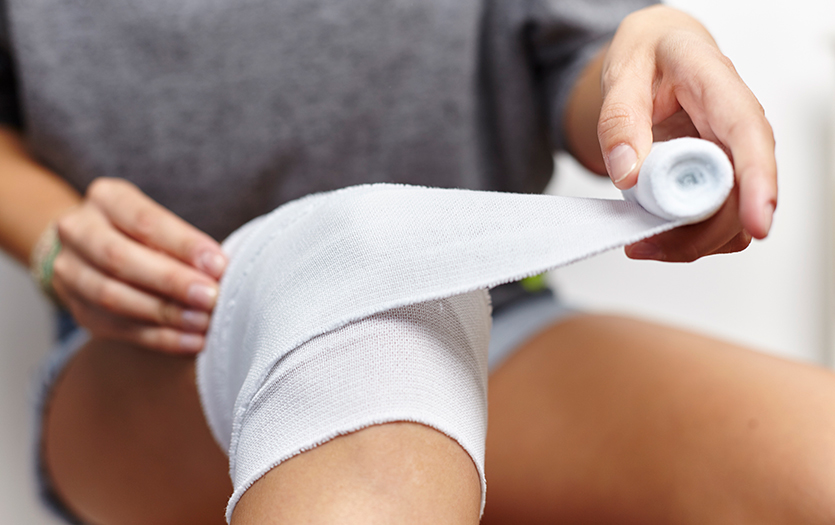
This post was written by Barbara Sagoe, MD, PPG – Family Medicine and PPG – Pediatrics.
Accidents happen. So do incisions from surgeries. Deep cuts and other wounds often require sutures (more commonly called stitches) or staples to help the wound close and heal. In this post, I’ll cover everything you need to know, from what stitches and staples are to how to care for your repaired wound.
What are stitches?
Stitches are special threads that are sewn through the skin to keep two edges of a wound, cut or incision together to ensure proper healing with minimal scarring, maintaining function and better cosmetic repair. They are sometimes also called sutures.
There are two main types of sutures: absorbable and non-absorbable. Absorbable sutures are made of materials that are supposed to dissolve on their own inside the body or skin as the wound heals. For that reason, absorbable sutures do not require removal. Examples of these include those made from animal products or synthetic polymer materials such as silk, nylon and Prolene.
Non-absorbable sutures, on the other hand, do not dissolve on their own and thus need to be removed after a period of time. The time required for removal usually depends on the part of the body where the sutures are placed. For example, sutures on the face are usually removed after about five days to reduce scarring, while sutures on the scalp are left for up to 10 days (one and a half weeks).
What are staples?
Just like sutures, staples are used to join the edges of skin together, but they are typically made from metal such as steel, titanium, nickel, chromium or iron, or sometimes even plastic. Staples are normally selected for wound closures that are deep and need quick closure. Unlike stitches, all staples require removal after a certain duration of time. That length of time is determined by where the staples are placed in the body.
When are stitches used vs. staples?
When someone presents with a wound, there are several goals that drive what types of closure the clinician will choose to treat the wound. First is to ensure homeostasis, that is, to stop the bleeding. Next is which type of closure will produce the least amount of scarring, while at the same time preserve function. The clinician also considers the need for further investigations such as CT scan or MRI.
With those reasons in mind, there are parts of the body that staples will not be considered for, such as the face since it does not permit meticulous cosmetic healing. Staples are also not used in the hands and feet due to increased risk for discomfort. If there is a need for further imaging such as CT or MRI, staples are also not used as metal could interfere with the procedure or the results. In all those cases, stitches are best.
Staples, on the other hand, are quick to apply and remove, meaning a shorter need for anesthesia. Some studies also show lower rates of infection with staples because of a lower tissue reaction to them.
How quickly should wounds be sutured or stapled?
The need for sutures or staples will be determined by your provider. Typically, wounds should be closed quickly, but clean wounds can be closed up to 18 hours after the injury occurred and even up to 24 hours if not on the face.
However, not all lacerations can be sutured right away. Some wounds require cleaning that cannot be done by the bedside under local anesthesia. These include if the wound is infected, is from an animal or human bite, or is a deep puncture wound, such as from a nail.
Additionally, some wounds may need specialized care, such as those involving the nerves, large lacerations that will require a prolonged period of time to repair, those that involve a fractured bone, or lacerations involving the nose, eyes or ears.
Make sure your tetanus vaccine is up to date
If you have a wound that requires staples or sutures, you want to make sure your tetanus booster is up to date. Depending on the type of wound, your last immunization should not exceed ten years for clean wounds or five years for a dirty wound. Let your provider know if you think you need a tetanus booster.
How to care for stitches and staples at home
The care for stitches and staples is similar. Here are a few important instructions:
- A dressing is usually applied in the hospital or clinic after closure with either an adhesive bandage or semi-occlusive dressing such as Tegaderm. Keep your dressing in place for about 24-48 hours.
- After your dressing is removed, apply antibiotic ointment 1-2 times a day to the wound to prevent crusting over.
- Do not soak the wound. Showers are okay, but swimming is not advisable.
- Continue this wound care until the staples or stitches are removed.
- Get your stitches or staples removed on time to avoid complications such as:
- Buried staples or stitches. This will cause a more difficult removal, even making additional incision to remove the buried stitch or staple.
- Increased scarring
When to seek care for stitches or staples
Call your doctor if there are any signs of infection including:
- Increasing redness
- Swelling and warmth around the wound
- Drainage
- Pain
- Fever
- Wound does not appear to be healing properly
Seek immediate care if you notice:
- Persistent bleeding
- Rapidly increasing swelling of the wound
- Increasing pain in the area
- Feeling of numbness in a digit or limb
- Gaping wound
When will my stitches or staples be taken out?
This depends on the location or anatomic site of the stitches or staples. Here are general guidelines:
- Face – 5 days
- Eyelids – 5 days on the average, but can be anywhere from 3-7 days depending on the tension on the wound
- Neck – 5 days
- Scalp – up to 10 days
- Arms and trunk – 7 days
- Legs – 8-10 days
- Hands and feet – 10-14 days
How to care for your wound after the stitches or staples are removed
- Clean the area with soap and water.
- Avoid using alcohol or peroxide on the area, as that can slow the process of wound healing.
- The area may still be tender after the removal but that improves over time.
- Washing or bathing should resume as usual.
- Swimming may be resumed, depending on the wound. Check with your provider first.
- Avoid prolonged exposure to sunlight as that may cause some tenderness.



